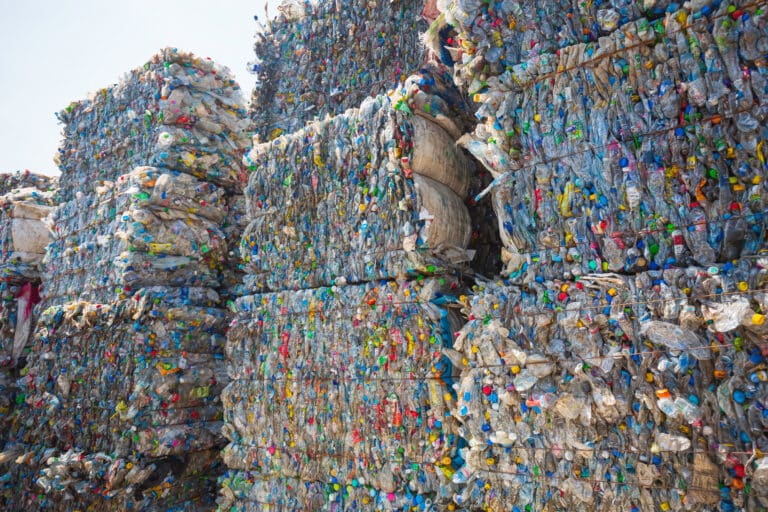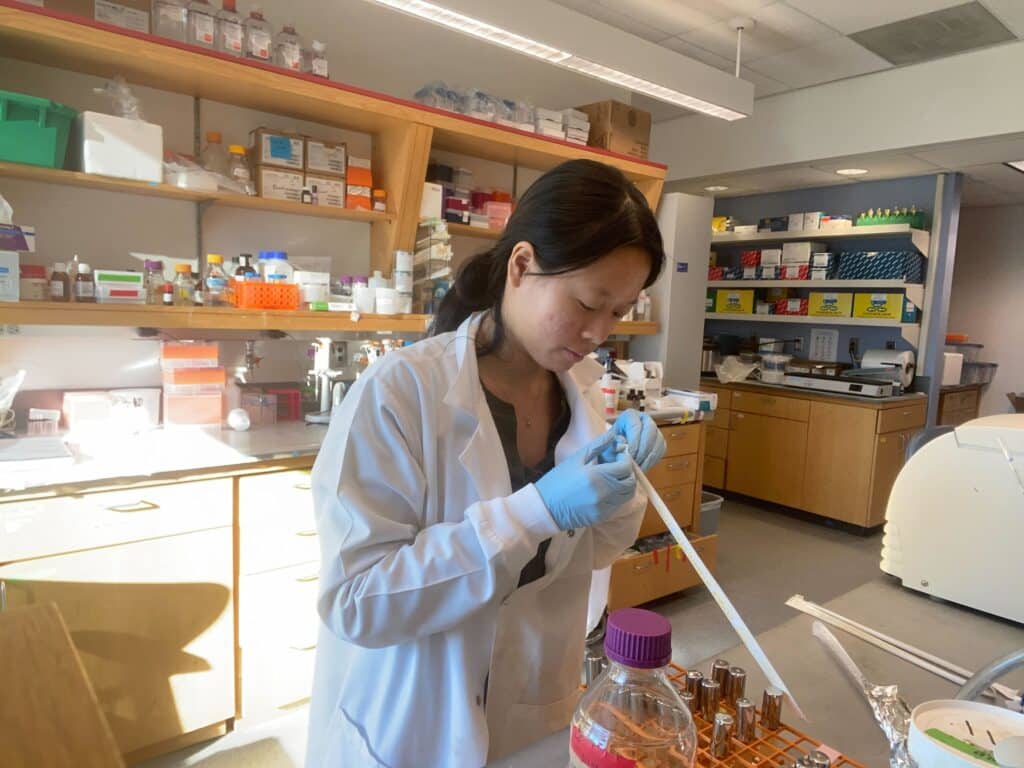4.1.24 [Just today from the institution]
CLAIRE ANDREASEN
An interdisciplinary Duke team harnesses the destructive powers of bacteria to break down plastics in the environment.

Duke
Researchers predict a startling future: By 2050, plastics in our oceans could outweigh fish. As plastic production continues to increase and trash collection systems continue to falter, plastic negatively impacts marine biodiversity and human health. Every week the average person consumes approximately five grams of microplastics, each gram laden with potentially cancer-causing additives. Amidst growing concerns about the impacts of plastic pollution on both public health and the environment, an interdisciplinary Duke team is researching bacteria with the potential to break down these synthetic materials.
The team is part of Bass Connections, a university-wide Duke program that gives students a chance to apply classroom lessons to complex societal challenges, working alongside faculty from all of Duke’s schools.
Jason Somarelli, professor of medical oncology, and Will Eward, orthopedic oncologist, conceived the idea of forming a Bass Connections team to address plastic pollution after coming across an article about a newly identified strain of plastic-degrading bacterium. “Will and I were growing increasingly concerned about plastic in the environment and so were our colleagues,” said Somarelli, who has worked as a team leader on the Bass Connections project —”Bioremediation of Plastic Pollution to Conserve Biodiversity”— for more than five years now.
Over the years, the group has worked to both uncover the health consequences associated with plastic additives and discover faster ways to degrade plastics using bacteria. The project has three main sub-teams: bioremediation, human health, and bioinformatics.
Sage Hirschfeld is a third-year environmental engineering major and a researcher on the bioremediation sub-team that works to accelerate plastic degradation via bacteria. Hirschfeld has worked primarily on combining cut190, an enzyme capable of degrading PET (Polyethylene terephthalate) plastics, with a bacteria called Thermus thermophilus that can degrade plastics at higher temperatures. This is useful because plastic is easier to degrade when it’s heated up.
“The idea is that we can degrade plastic more efficiently if we heat it up to the point where it starts to lose its structure, which is called its glass transition temperature,” Hirschfeld noted. “At the end of last year, I was finally able to get the gene into that bacteria and see that it was working, which was so exciting.”
Ashley Huang, a second-year environmental engineer who recently joined the bioremediation group, is helping build a device that can cut plastic into smaller pieces that bacteria can more readily digest. The device will be useful as they test Pseudomonas stutzeri bacteria, a strain that the lab previously showed to have degrading properties, on more complex plastic polymers such as PET. “PET plastic, which is commonly used, is pretty complex, so we’re seeing how far we can push the P. stutzeri,” said Huang.

Duke
On the bioinformatics sub-team, students use computational skills to analyze which bacteria may exhibit degrading properties and which plastic additives may be carcinogenic. This analysis is often the basis of further wet lab research performed by the other sub-teams. As Cadmus Yeo, a graduate biomedical engineering student noted, “On the bioremediation side, a lot of the systems we plan to manipulate have gotten to us because the bioinformatics team has done the computational groundwork.”
For instance, last year the bioinformatics sub-team was able to map the structure of the proteins responsible for PET degradation and then scan the other strains of bacteria for similar structures. They found that a soil bacterium, Pseudomonas stutzeri, contained two plastic-degrading enzymes, PETase and MHETase. “Our bioremediation team was then able to get that bacteria and validate that result,” Hirschfeld explained.
The bioinformatics team also works to uncover which plastic additives — materials added to plastics to improve performance —might be harmful to human health. The team accomplishes this by extracting gene expression information from databases and comparing it to the characteristics of known carcinogenic additives to find possible matches. Last year, they performed a toxicogenomic analysis on 2,712 additives, discovering more than 150 additives with carcinogenic potential.
On the health team, project members test polymers with plastic additives on live cell cultures. They do this by creating sample plastics containing potentially harmful additives, exposing them to cell cultures, and then looking at cell viability, DNA damage, and gene expression markers that are related to cancer.
Bea Schleupner, a team leader and lab manager who joined the group as an undergraduate, explained how the lab tries to generate sample plastics that are representative of what is actually found in the environment.
The project’s multifaceted focus requires a highly interdisciplinary team, which is the hallmark of the Bass Connections program. This year’s team consists of three graduate students from the Departments of Biomedical Engineering and Ecology as well as six undergraduate students from the Departments of Environmental Engineering, Computer Science, and Biology. “I think what is most impressive is that all these people come from really diverse disciplines and are yet all so interested in biological sciences and biological engineering,” said Yeo.
Schleupner was initially drawn to the project because of its multidisciplinary focus. “I found that this project was looking at a really cool intersection of environmental issues and human health,” Schleupner said. Indeed, some of the most effective environmental legislation has historically come after we realized the health implications of pollutants; as Schleupner pointed out, the Montreal Protocol (a treaty that banned ozone-depleting chemicals) was drafted after research revealed that a thinning ozone layer would increase the risk of skin cancer in humans. “If we can show people evidence that plastic is harmful in the long run, that will provide more of an impetus for people to act on plastic pollution,” Schleupner said.
Somarelli said the goal of the Bass Connections team is to equip talented students with all the tools they need to go on and solve big problems. Undergraduates like Hirschfeld and Schleupner describe the team as having a supportive environment that fosters independence. “It was very exciting to write out my first experiment procedure and then get to do it in the lab,” said Hirschfeld.
And graduate students serve an important mentorship role on the team. “I have gotten this really cool opportunity to advise these undergrads, help them design their experiments, and help them troubleshoot when things go wrong,” Yeo said.
Currently, the team is working on testing their findings on more complex plastics and experimenting with heat-aided degradation. In the future, the group aims to engineer a bioreactor that can break plastic down into chemical components that can be reused. “There are actually ways to break those products down and transform them into valuable platform chemicals,” Yeo explained. “This valorization was something I was super interested in and something I think the bioremediation team is really well poised to do.” And further down the road, they aim to assess and improve on the product lifecycle as a whole. “We can envision this circular plastic economy where all of the final products that we make can be degraded completely back to their original components,” said Schleuper.
See the full article here .
Comments are invited and will be appreciated, especially if the reader finds any errors which I can correct.
five-ways-keep-your-child-safe-school-shootings
Please help promote STEM in your local schools.
Younger than most other prestigious U.S. research universities, Duke University consistently ranks among the very best. Duke’s graduate and professional schools — in business, divinity, engineering, the environment, law, medicine, nursing and public policy — are among the leaders in their fields. Duke’s home campus is situated on nearly 9,000 acres in Durham, N.C, a city of more than 200,000 people. Duke also is active internationally through the Duke-NUS Graduate Medical School in Singapore, Duke Kunshan University in China and numerous research and education programs across the globe. More than 75 percent of Duke students pursue service-learning opportunities in Durham and around the world through “DukeEngage” and other programs that advance the university’s mission of “knowledge in service to society.”
Duke University is a private research university in Durham, North Carolina. Founded by Methodists and Quakers in the present-day town of Trinity in 1838, the school moved to Durham in 1892. In 1924, tobacco and electric power industrialist James Buchanan Duke established The Duke Endowment and the institution changed its name to honor his deceased father, Washington Duke.
The campus spans over 8,600 acres (3,500 hectares) on three contiguous sub-campuses in Durham, and a marine lab in Beaufort. The West Campus—designed largely by architect Julian Abele, an African American architect who graduated first in his class at the University of Pennsylvania School of Design —incorporates Gothic architecture with the 210-foot (64-meter) Duke Chapel at the campus’ center and highest point of elevation, is adjacent to the Medical Center. East Campus, 1.5 miles (2.4 kilometers) away, home to all first-years, contains Georgian-style architecture. The university administers two concurrent schools in Asia, Duke-NUS Medical School in Singapore (established in 2005) and Duke Kunshan University in Kunshan, China (established in 2013).
Duke is ranked among the top universities in the United States. The undergraduate admissions are among the most selective in the country, with an overall acceptance rate of about 5.5%. Duke spends more than $1 billion per year on research, making it one of the ten largest research universities in the United States. More than a dozen faculty regularly appear on annual lists of the world’s most-cited researchers. Nobel laureates and Turing Award winners have been affiliated with the university. Duke alumni also include Rhodes Scholars, Churchill Scholars, Schwarzman Scholars, and Mitchell Scholars. The university has produced one of the highest number of Churchill Scholars of any university (behind Princeton University and Harvard University) and high numbers of Rhodes, Marshall, Truman, Goldwater, and Udall Scholars. Duke is the alma mater of presidents of the United States and many living billionaires.
Duke is the second-largest private employer in North Carolina, with more than 39,000 employees. The university has been ranked as an excellent employer by several publications.
Research
Duke’s research expenditures are in the billions of dollars, very high in the U.S. Duke receives millions in funding from the National Institutes of Health. Duke is classified among “R1: Doctoral Universities – Very high research activity”.
Throughout the school’s history, Duke researchers have made breakthroughs, including the biomedical engineering department’s development of the world’s first real-time, three-dimensional ultrasound diagnostic system and the first engineered blood vessels and stents. In 2015, Paul Modrich shared the Nobel Prize in Chemistry. In 2012, Robert Lefkowitz along with Brian Kobilka, who is also a former affiliate, shared the Nobel Prize in chemistry for their work on cell surface receptors. Duke has pioneered studies involving nonlinear dynamics, chaos, and complex systems in physics.
In May 2006 Duke researchers mapped the final human chromosome, which made world news as it marked the completion of the Human Genome Project. Reports of Duke researchers’ involvement in new AIDS vaccine research surfaced in June 2006. The biology department combines two historically strong programs in botany and zoology, while the divinity school includes leading theologians. The graduate program in literature boasts several internationally renowned figures, while philosophers contribute to Duke’s ranking as the nation’s best program in philosophy of biology, according to the Philosophical Gourmet Report.



